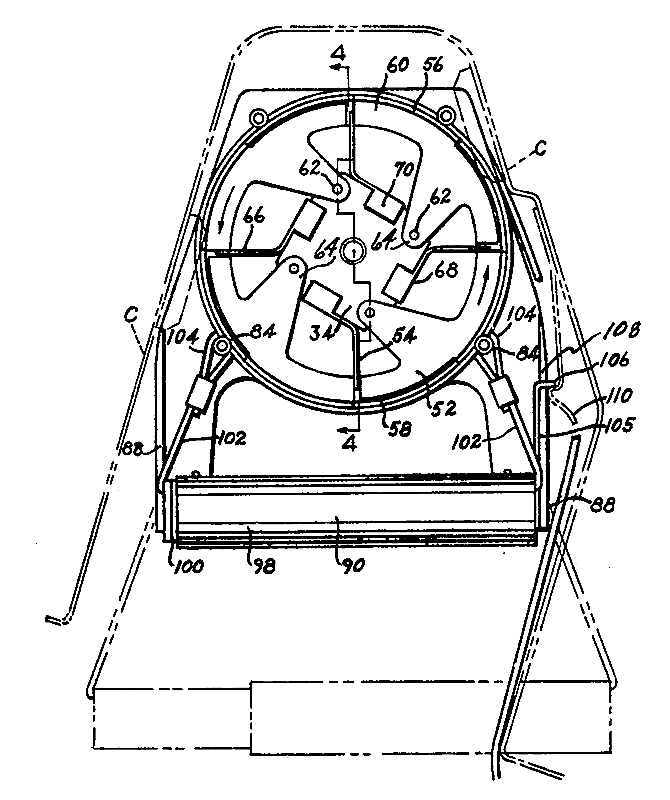Technical Details
 I acquired this Frost Engineering Development Corporation 747 Pilot Emergency Decent Device from Kevin R. Smith in 2025.
I acquired this Frost Engineering Development Corporation 747 Pilot Emergency Decent Device from Kevin R. Smith in 2025.
My Decent Device is 194 mm. tall, 178 mm. wide, 31 mm. thick, and weighs 1186 g.
The Decent Device has a stamped outer casing that encloses a reel of steep tape wound on a storage drum. A telescoping handle is stored at the bottom of the casing. A sharp pull releases the handle, which drops and extends to a size that allows the user to grip the handle with both hands for descent.
The steel tape on the drum is attached to a short steel cable with a loop at the end for fastening to a secure anchor. As the user descends, the reel unwinds, releasing the tape. Pivoting brake shows centrifugally extend to contact a brake drum on the inner reel surface, limiting the maximum rate of descent.
As the ribbon pays off the reel, pivoted brake shoes carried thereby extend centrifugally into contact with a stationary brake drum forming a part of the case and thus limit the maximum rate of descent to a predetermined level for a load of given weight. Provision is made for keeping the tape or ribbon tightly coiled so, that no slack must be taken up prior to the commencement of reel rotation ans the centrifugal braking action that is a function of the latter. Provision is also made for rewinding the payed out tape for reuse.
The front has a label printed with "DESCENT DEVICE," "PART NO. 379103-1," "Patents Pending", "SPEC NO. S379–1," SERIAL NO. 0596 ," "DATE OF MFR. 18 September 1970 ," "P.O. NO. Y–510929–7065E ," "NOTE: THIS DEVICE IS LIMITED TO 30 USES," the Frost Engineering Development Corporation logo, "Frost Engineering Development Corporation," and "ENGLEWOOD, COLORADO 80110."
The rear has a label printed with and illustration on the right and text on the left saying "RE–INSTRUCTIONS," "1. Remove a yellow disc after descent. (THIS DEVICE IS LIMITED TO 30 DESCENTS)." "2. Insert 3/16 Allen wrench into socket below. Turn clockwise until tape–to–cable connection is drawn into case below slot like this →" with the arrow pointing to a specific point on the the illustration, "3. Loop cable into case above slot like this →" with the arrow pointing to a specific point on the the illustration, 30 removable yellow dot stickers, "REWIND" and two clockwise arrows surrounding the drum rewind wrench opening, "4. Slide grommet along cable and insert (thin end down) into slot like this →" with the arrow pointing to a specific point on the the illustration, "5. Stow surplus cable by pushing exposed cable through grommet into case." "6. Compress handgrip tubes and insert between legs of case, guiding R.H. strap loop to stow beneath clip end like this→" with the arrow pointing to a specific point on the the illustration, and "7.Apply bead of tamper–proof sealant (SM EC–1252 or equiv.) over inbd. and bottom edges of grommet and adjacent surface of case.
Frost Engineering Development Corporation received U.S. Patent #3,602,483 for the Emergency Decent Device in 1971. The patent lists some novel design requirements. My favorite is the one to avoid requiring any form of harness. Instead, the user must grip a handle with both hands and hold on while they descend. I do not completely understand how disabled passengers, young children, infants, etc. would safely use this device without self-Darwining. Be that as it may, someone in the aviation industry decided that this device was suited for pilots, and adopted it for selected 747-series aircraft.
Another design requirement is to not allow the user to have any control over the descent rate. I am biased, and the idea of having a descender designed to deny me any and all control over my rate of descent does not appeal to me. I can, however, see situations when some people should not be given that control, and I would not assume that all random passengers exiting a burning airliner would act rationally, despite that being in their best interest.
Frost limits their unit to 30 descents, allowing pilots to train on the device and then survive several careers worth of flaming plane crashes. They provided 30 small stickers so that survivors could remove one after each use to help keep a count. My later Capewell Components unit requires returning their unit to the manufacturer after each use, forcing the user to decide between training, crashing, or buying multiple units. To those who understand aviation regulations, the Capewell approach may make sense.
I do not recommend this device for recreational caving of climbing use. It was designed for a different application, and some of the design requirements and executions are not consistent with our needs
History
I have two of these. The first, made in 1970, was from Frost Engineering Development Corporation of Englewood Colorado. Capewell Components acquired Frost Engineering in 1994. My second unit came from Capewell who reconditioned it in 2006.



